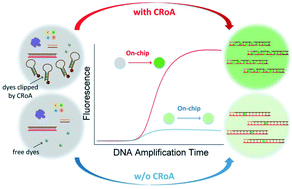Clip-to-release on amplification (CRoA): a novel DNA amplification enhancer on and off microfluidics†
Abstract
Despite its high sensitivity, low cost, and high efficiency as a DNA amplification indicator with a yes/no answer, dsDNA-binding dye encounters incompatibility when used in microfluidic systems, resulting in problems such as false negative amplification results. Besides, its inhibition of amplification at high concentrations hinders its application both on-chip and off-chip. In this study, we propose a novel DNA amplification enhancer to counteract the drawbacks of dsDNA-binding dyes. It acts as a temporary reservoir for the free-floating dyes in solution and releases them on demand during the amplification process. Through this clip-to-release on amplification mechanism, the enhancer lowered the background fluorescence of sample droplets before amplification, enhanced the signal-to-background ratio of positive samples, and eliminated the false negative signal of on-chip PCR. Moreover, the enhancer increased the off-chip polymerase chain reaction (PCR) efficiency, boosted the fluorescence signal up to 10-fold, and made less nonspecific amplification product. All the factors affecting the enhancer's performance are investigated in detail, including its structure and concentration, and the types of dsDNA-binding dye used in the reaction. Finally, we demonstrated the broad application of the proposed amplification enhancer in various DNA amplification systems, for various genes, and on various amplification platforms. It would reignite the utilization of dsDNA dyes for wider applications in DNA analysis both on-chip and off-chip.



 Please wait while we load your content...
Please wait while we load your content...